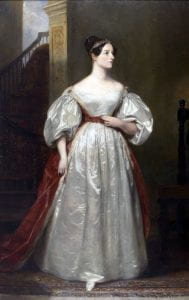Ada Lovelace (1815-1852) was the daughter of the poet Lord Byron and his wife, Anne Isabella (Annabella) Milbanke or Lady Wentworth (commonly known as Lady Byron).
Lovelace was a pioneer of computer science, an English Mathematician and writer who became friends with Charles Babbage, Professor of Mathematics at the University of Cambridge. Ada is known for her work on Babbage’s designs for a mechanical general-purpose computer, known as the ‘analytical engine’. Lovelace was the first to recognise that the machine had uses beyond calculation or number crunching and published the first computer program. She is often regarded as the first computer programmer over 100 years before modern computers were even created. Lovelace’s educational talents brought her into contact with scientists such as Andrew Crosse, Sir David Brewster, Charles Wheatstone, Michael Faraday, and the author Charles Dickens. Ada’s privileged social standing and liberal parents enabled her to be educated in subjects usually reserved for men of her era. Lovelace taught at the Ealing Grove Industrial School founded by Lady Byron; the first of its kind for under-privileged children.
Ada married William King in 1835. King was made Earl of Lovelace in 1838 and Ada become Countess of Lovelace. They had three children. Ada died at the age of 36 – the same age at which her father had died – in 1852, from cancer of the womb. Since her death Lovelace has received many posthumous accolades for her work.
The second Tuesday of October marks Ada Lovelace day in recognition of her groundbreaking contribution to computer technology.
Sources:
Ada Lovelace day: we should never forget the first computer programmer

